- Created by CAE author, last modified on Mar 01, 2024
Signing up for free to Zoom includes Basic features which, however, do not:
- support Zoom service integration into other applications
- contain cloud recording
and restricts the duration of meetings to 40 minutes if there are more than 3 total participants at the meeting.
In order to use Zoom services with CAE LearningSpace after completing the API setup as described in the previous part, you need to upgrade your account and include as many hosts in your subscription plan as many virtual rooms you would like to configure and run concurrently in CAE LearningSpace.
- Upgrade your account to Pro if you plan to use 9 virtual rooms or less at the same time;
- Upgrade your account to Business if you plan to use 10 or more virtual rooms at the same time.
Once you finish registering your free Zoom account, you will be redirected to your profile, where you can find your account number, personal meeting ID, account information, and meeting capacity.
You can also view your subscription status in the Licence field on your Profile, under Account:
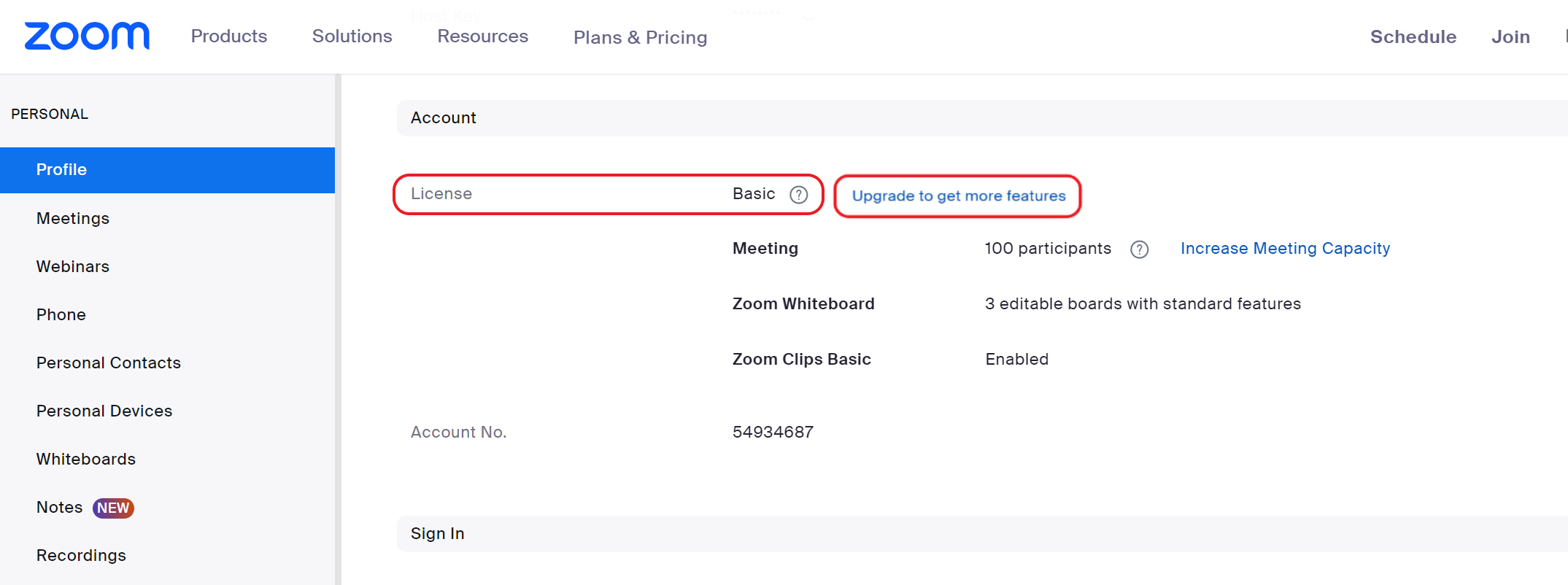
Virtual room configuration in CAE LearningSpace is explained on the next page.
Upgrade Your Zoom Account:
Change Your Plan
- Click on Upgrade in the Licence field on your profile next to your current subscription status.
You will be redirected to the Plan Management tab inside Plans and Billing. - Click on Manage and Edit Plan.
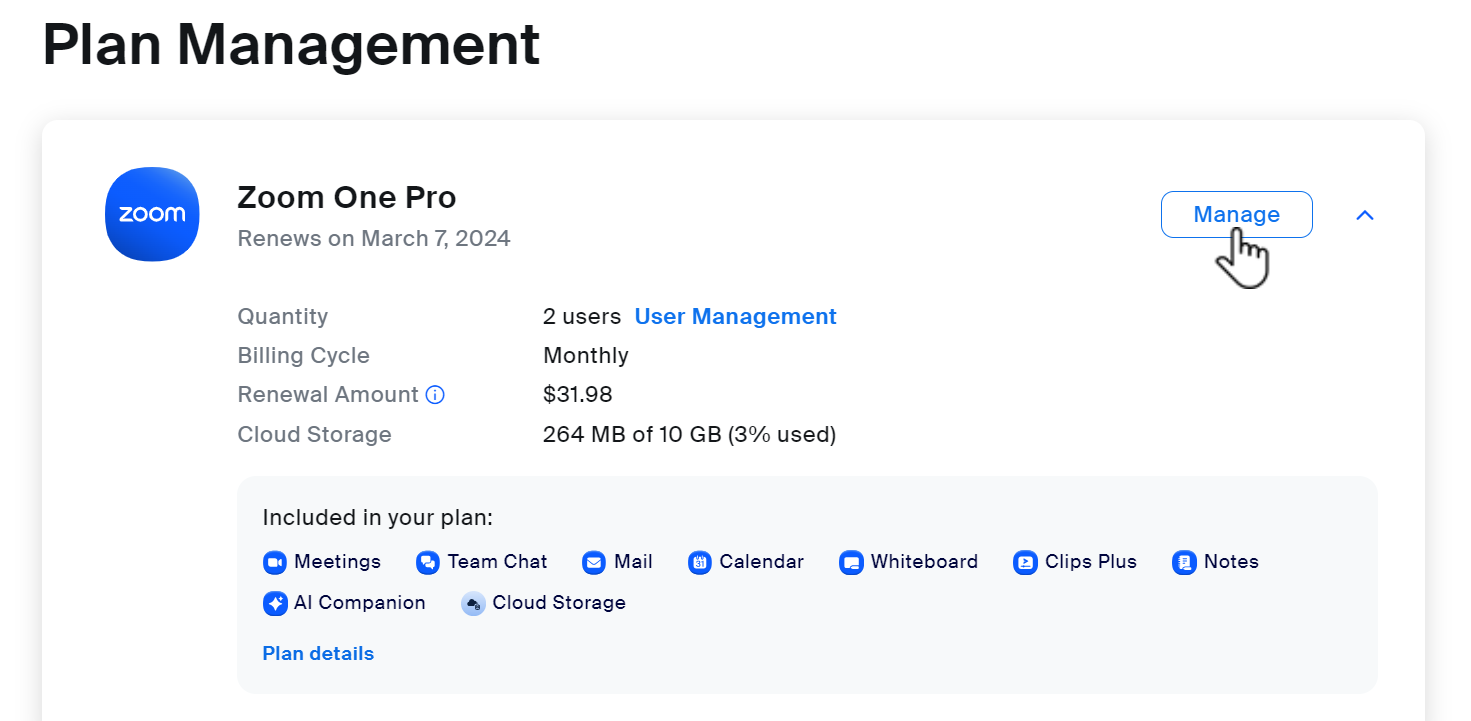
You will be redirected to the Edit Plan page. - Go to Switch plan if you want to modify your subscription plan:
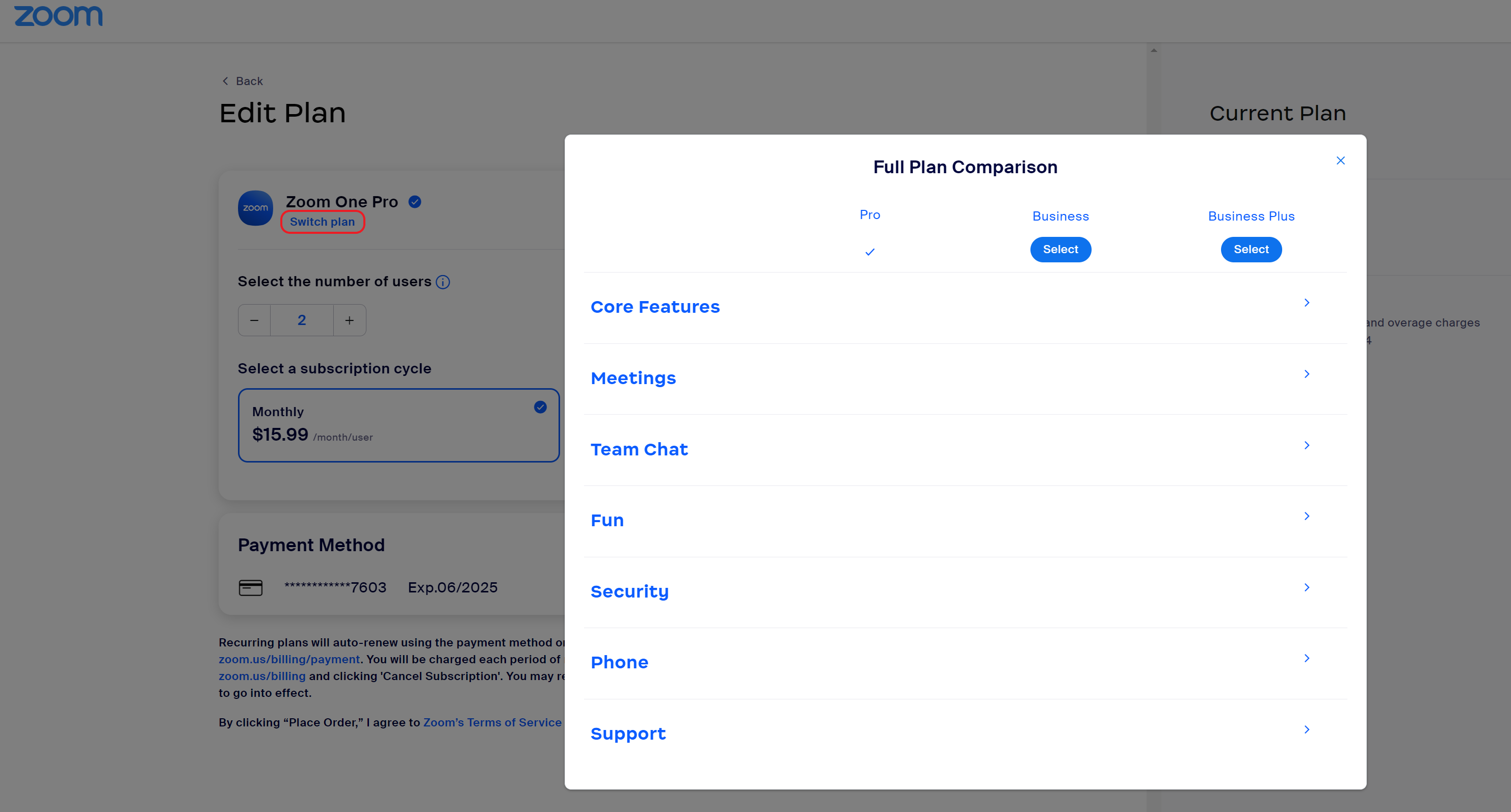
- Select Pro if you plan to configure 9 virtual rooms or less (up to 9 licenses);
Select Business if you want to configure 10 or more virtual rooms (up to 99 licenses).
- On your Current Plan page, select the number of users and subscription cycle:
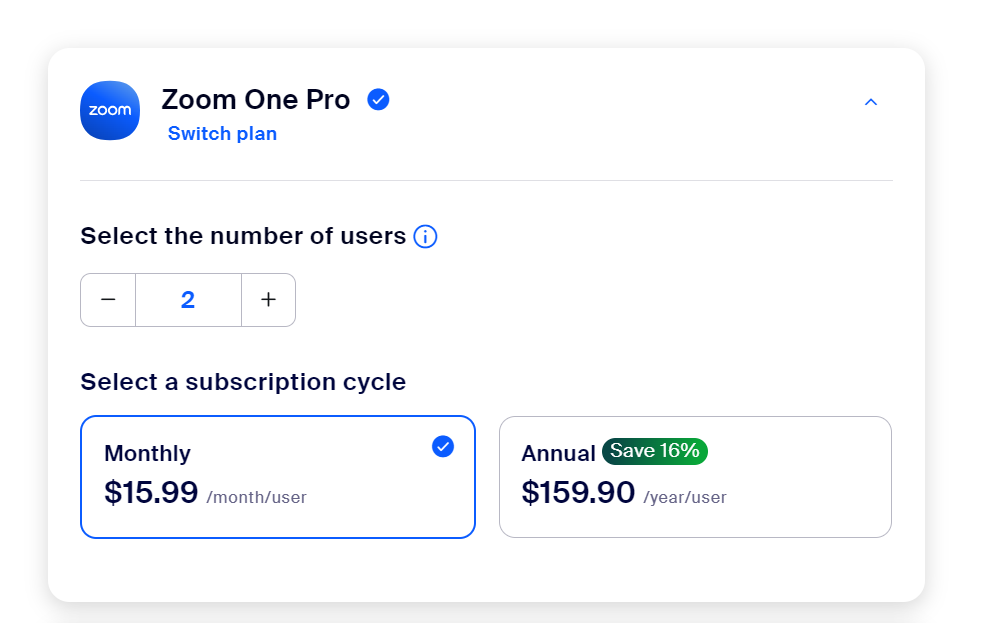
Zoom automatically calculates the monthly and annual fees afterwards.
Add Cloud Storage
CAE LearningSpace stores the recordings of virtual events temporarily in Zoom's cloud: the recording of a meeting is first saved to Zoom. The video recording will be downloaded from the cloud through a secure HTTPS channel to the Video Review module.
Downloading virtual event recordings to CAE LearningSpace might take some time, so to ensure that your Zoom account has enough room to store every recording of a virtual event temporarily, we recommend purchasing the extra 100 GB/month/licensed host solution (as mentioned below).
By default, Zoom offers 1 GB/month free cloud storage per licensed user (starting from Pro subscription), which will most likely be exceeded while conducting a virtual event.
To avoid running out of space in your Zoom cloud storage, cloud recordings are automatically moved to the trash folder in your Zoom owner account once CAE LearningSpace has successfully downloaded virtual event recordings to the Video Review module.
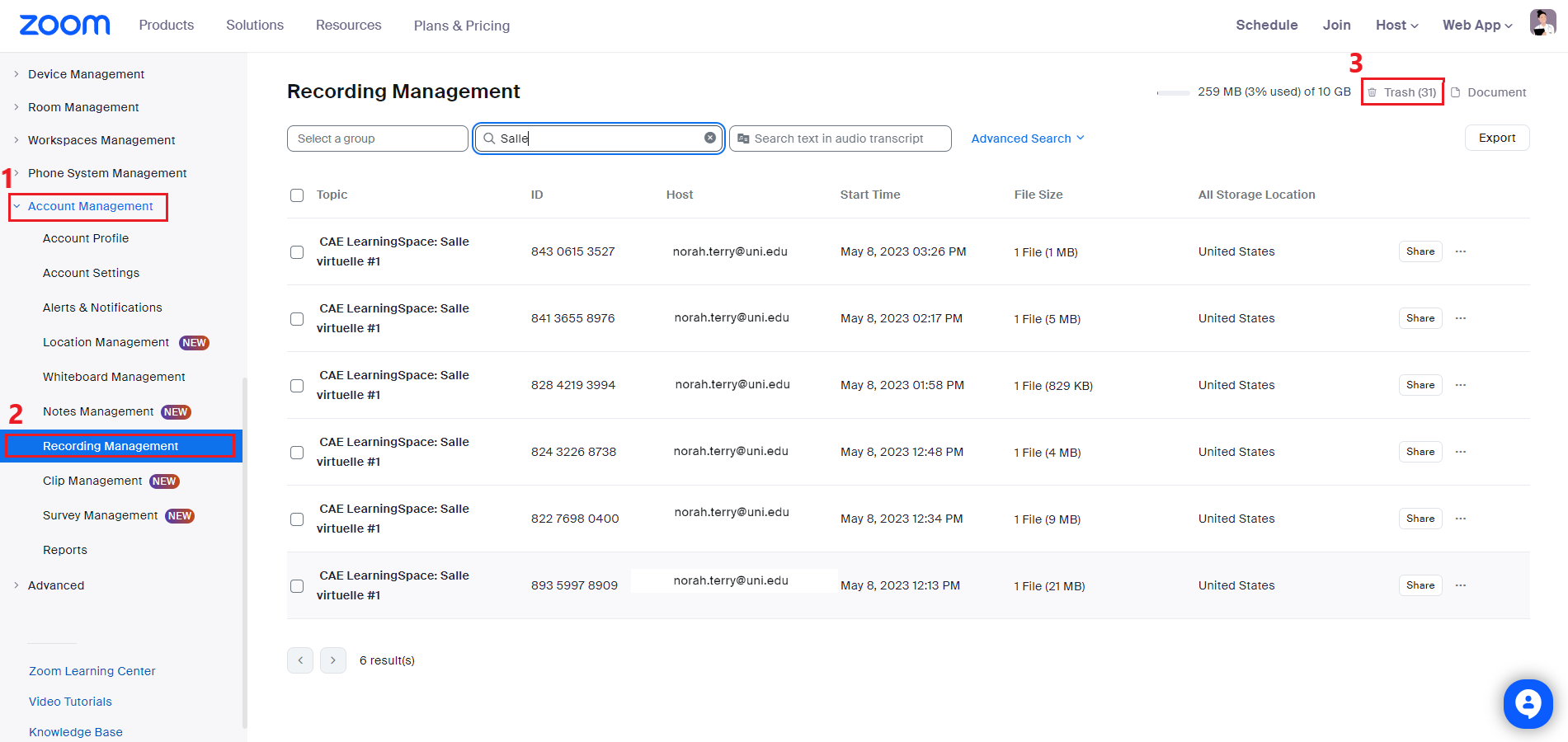
The recordings will be stored for another 30 days until deleted automatically.

Disable Automatic Transfer of Zoom Cloud Recordings to the Trash Folder
Would you like your cloud recordings to remain in the Recording Management folder after they have arrived in the Video Review module? Upon your request, we can disable the automatic transfer of Zoom cloud recordings to Trash. Contact CAE LearningSpace Customer Service for more information.
In Case Recordings Get "Stuck" in the Cloud
Downloading virtual event recordings from Zoom's cloud to CAE LearningSpace might take some time. Still, if you notice that the recordings have not arrived in the Video Review module within 6 hours, we recommend retrieving the meeting recordings and uploading them to CAE LearningSpace. Continue to this page for instructions on how to recover your recordings from Zoom's cloud.
Open Plan Management, go to Cloud Storage and click Add.
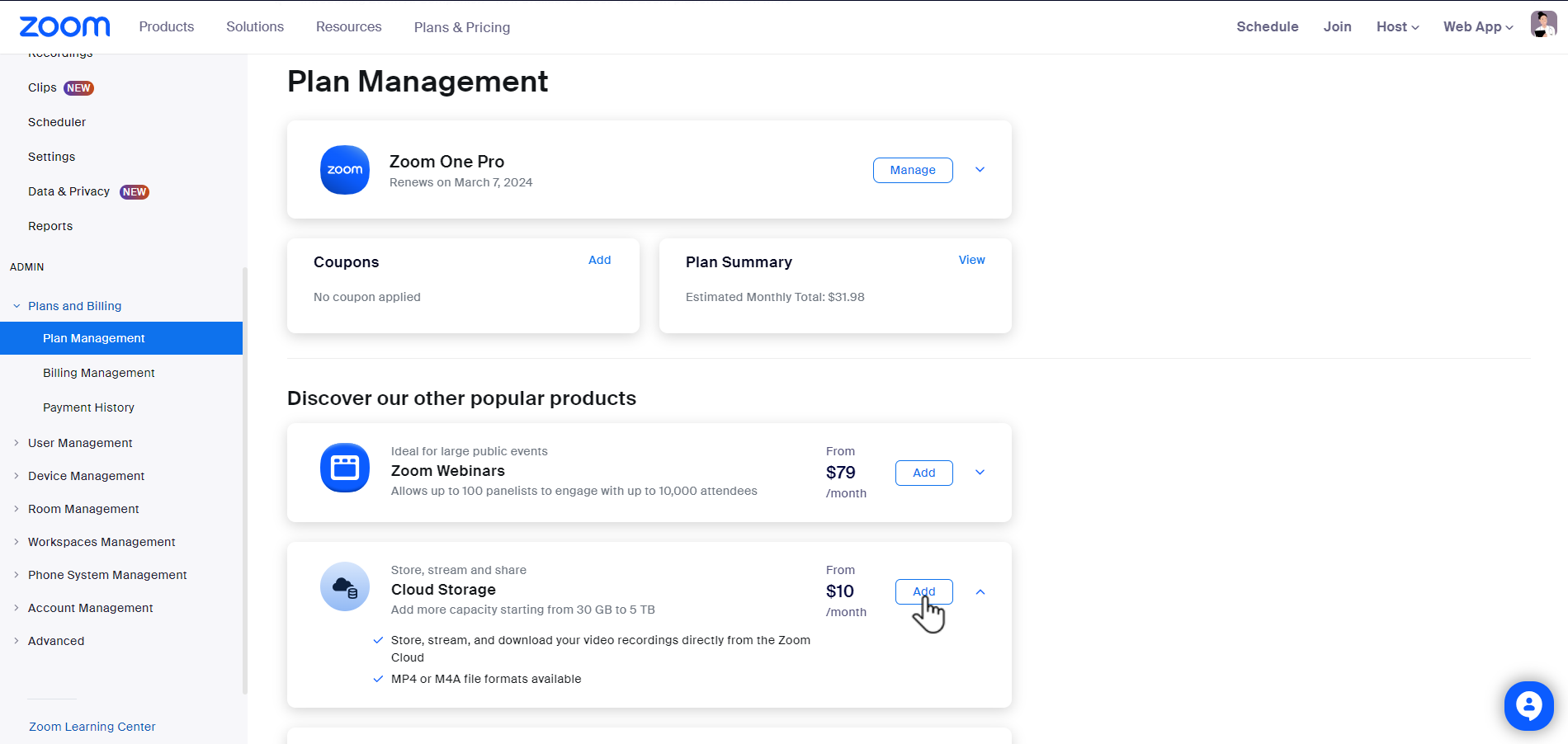
To accommodate the temporary recordings of (even) a day's worth of OSCE training/examination, purchase the extra 200 GB/month solution:
On the Payment tab, provide the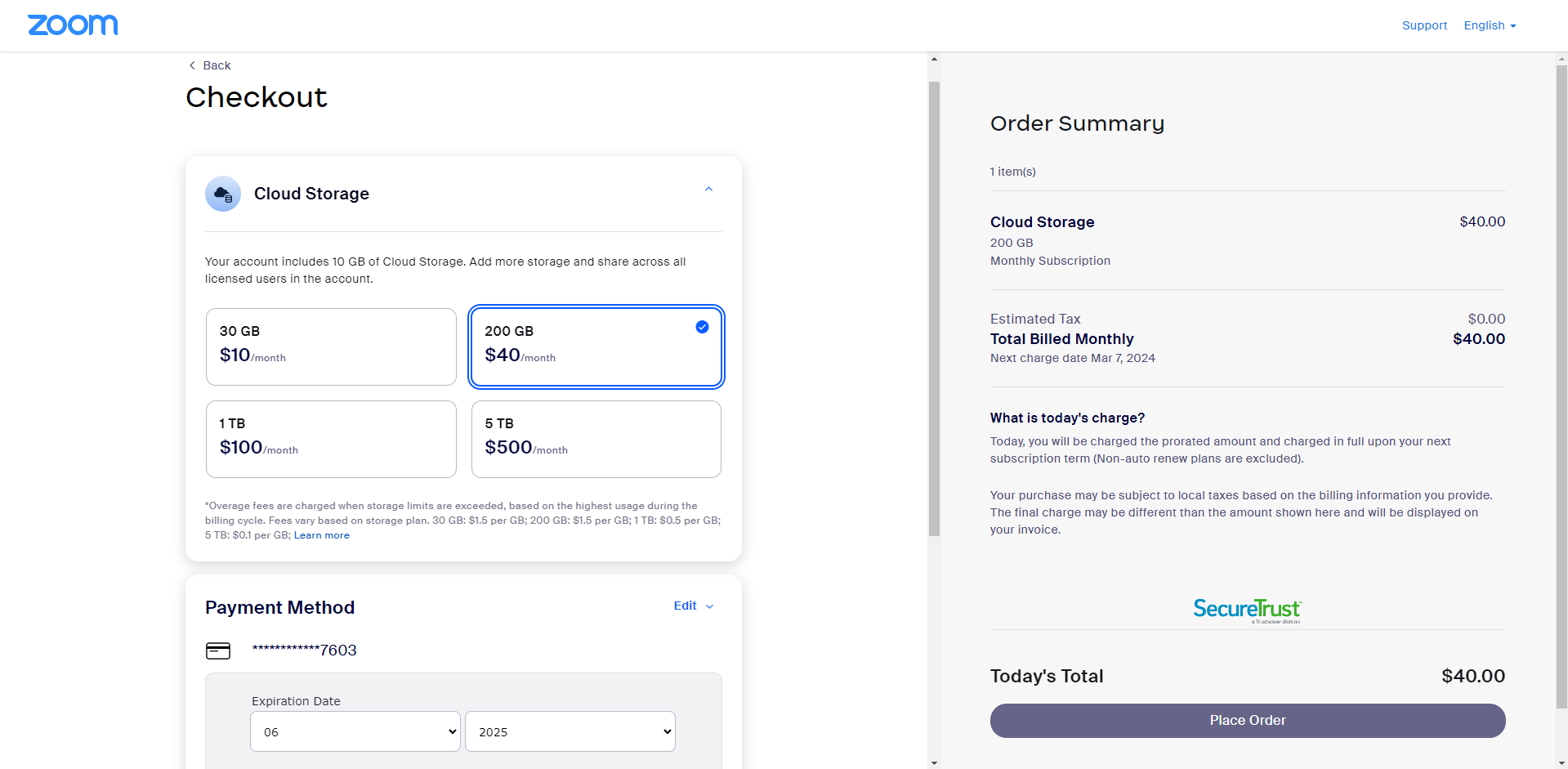
Billing Contact information
Besides basic details, the total employee count of your organization is required to continue.
- Payment Method, and
- Credit/debit card information.
- Once you are finished, click Place Order. You will be presented with an Order Summary.
- Click Confirm to complete your purchase.
Zoom will confirm that your account has been upgraded successfully.
Following the Account Upgrade
Remove the License from the Owner Account
Important
After upgrading your account, Zoom automatically sets the Owner user—you—to "Licensed."
This will occupy one of the hosting licenses that one of your virtual rooms should be having instead.
Important
CAE LearningSpace refuses to create a new virtual room and its user account in Zoom once your account runs out of licenses.
Solution
Set your account type back to "Basic" to free up a hosting license that you can apply to a virtual room.
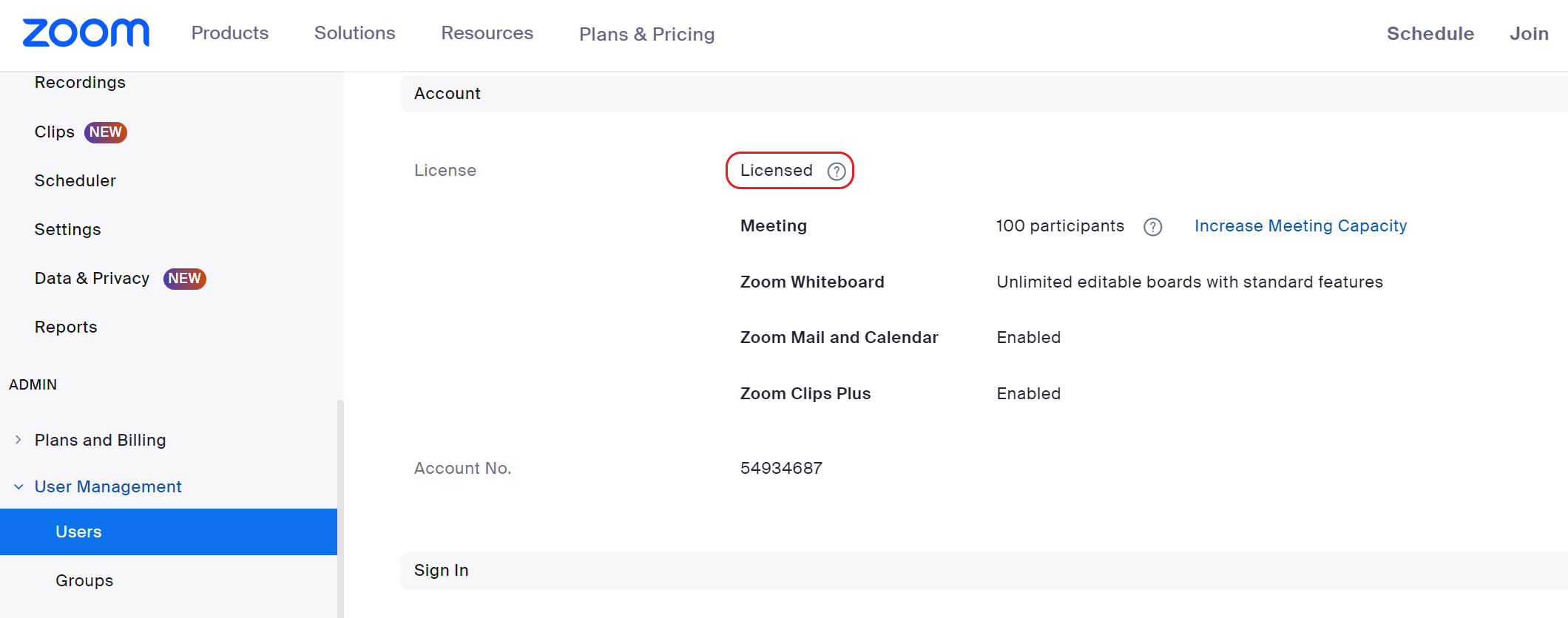
- Click on User Management in the sidebar next to your Zoom profile.
Select Users.
You will be presented with your owner account on the Users tab.In the tab's header, you can see the number of remaining licenses you can assign to virtual rooms (here, the number of remaining licenses is 8 out of the total of 9).

If

- Click on Edit in the row of your owner account.
The Edit User pop-up opens. - In the User Type row, select the Basic radio button to switch your account to basic and free up a virtual room license.
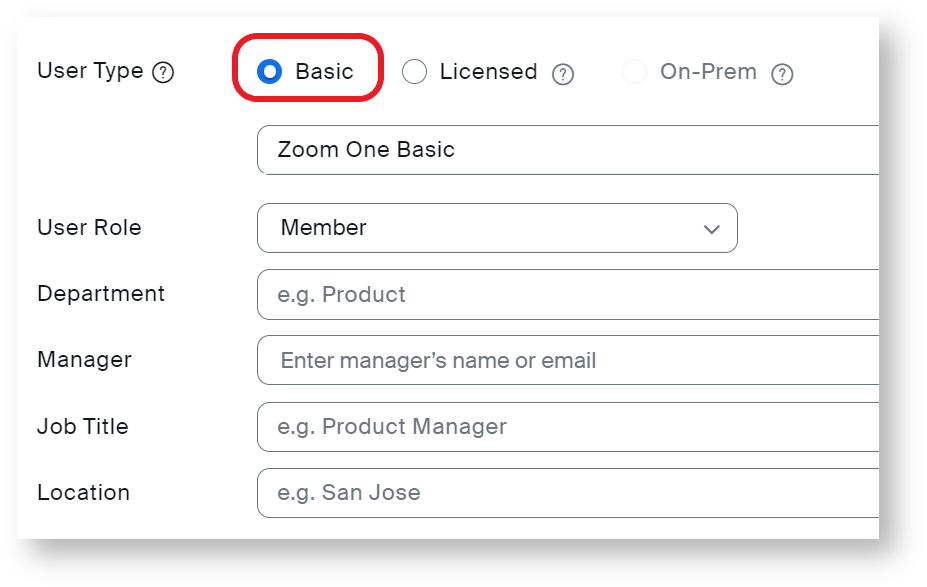
Click Save.
Your owner account type has changed to "Basic."In the tab's header, the number of licenses you can apply increases by one (to 9 in our example).
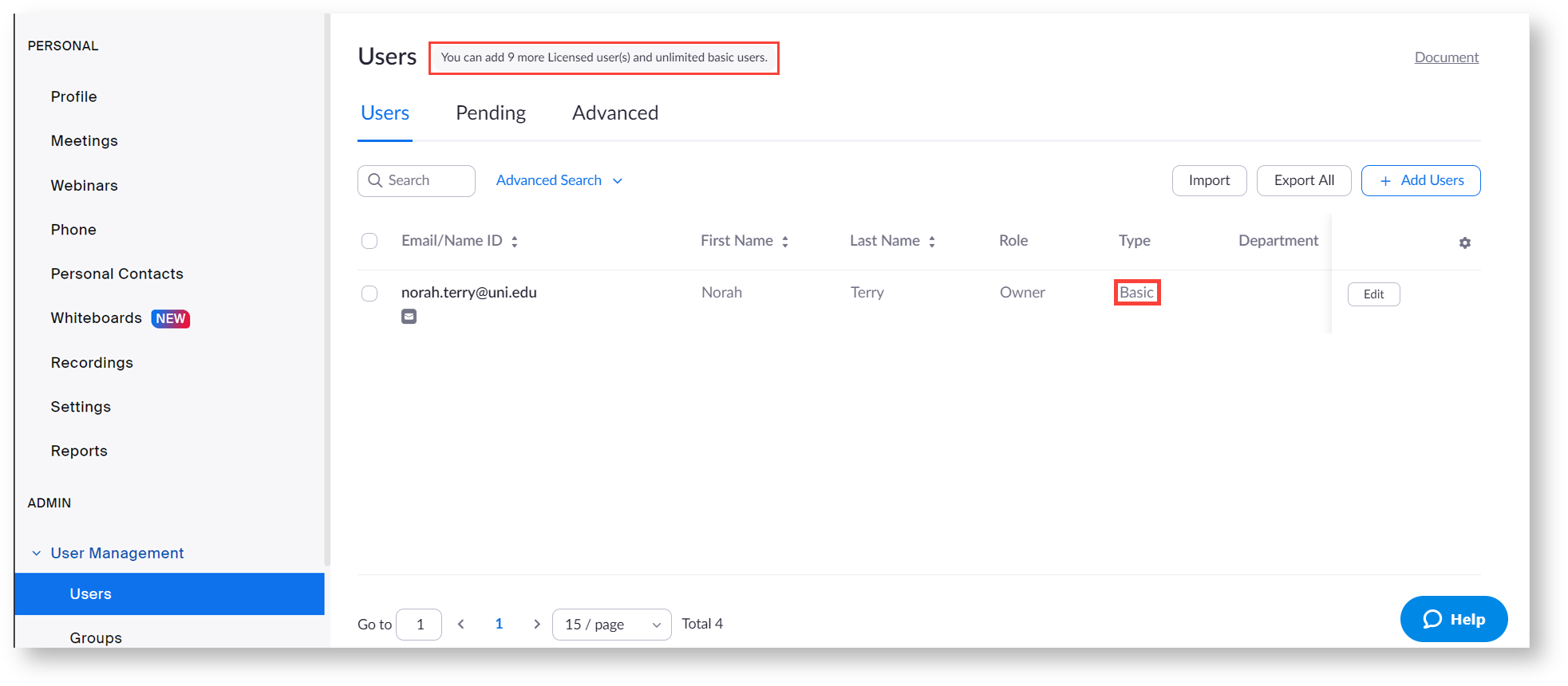
Disable Waiting Rooms
Zoom has enabled the Waiting Room feature by default in their May 2020 update. SPs need to admit each learner to the virtual encounter they are currently hosting if waiting rooms are enabled.
To disable this feature:
- Log into your Zoom owner account.
- Open Account Management on the left.
- Go to Account Settings.

- On the Meeting tab, scroll down to the Waiting room setting.
You can find the setting right away in the Security section.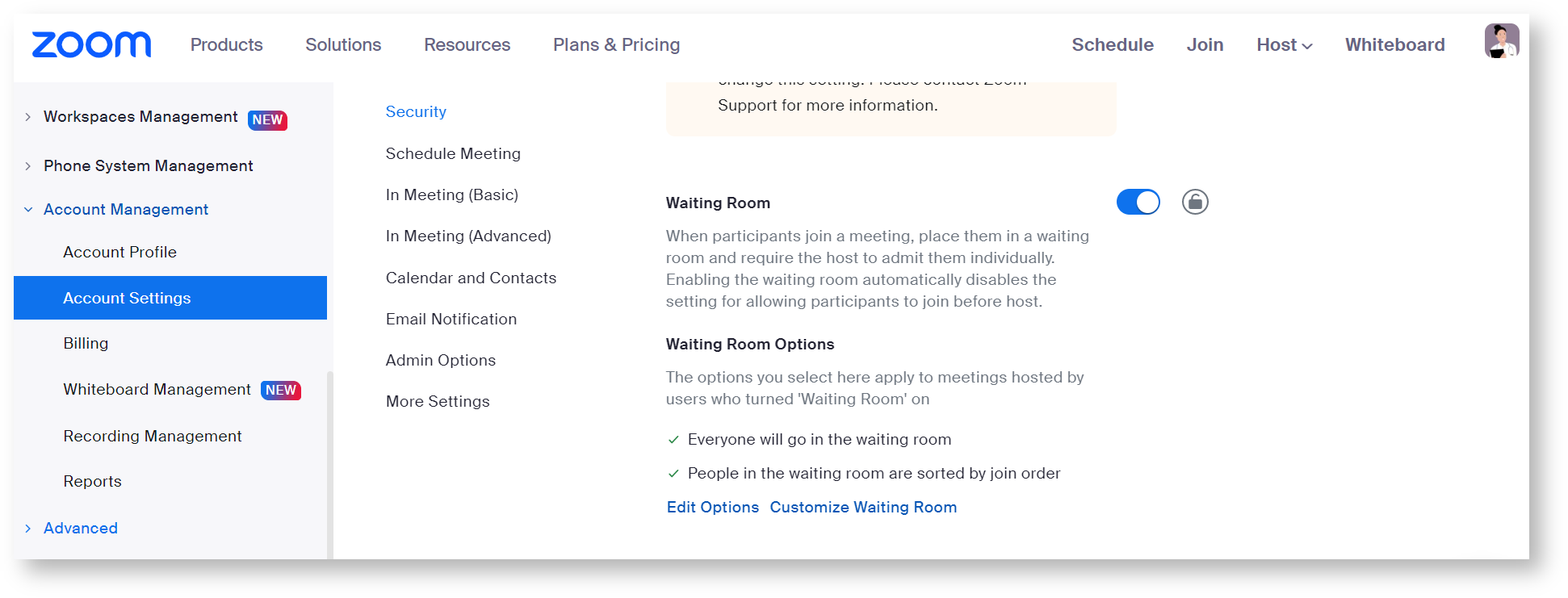
- Toggle the switch on "Waiting room."
A dialogue will open where you have to confirm the setting: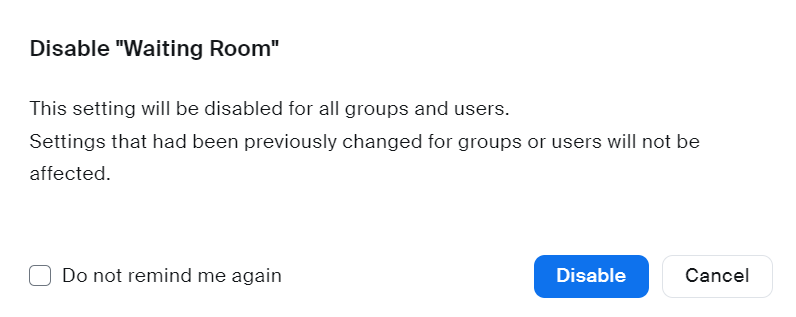
- Click Turn Off, and your change will be saved automatically.
Enable Auto-Save for Chat Conversations
Chat conversations are not saved along with virtual encounter recordings to CAE LearningSpace.
Enable automatic chat saving to have chat conversations saved locally or to the cloud when SPs end their virtual encounters.
Save Chats to the Cloud
Saving Chat Conversations to the Cloud
Save in-meeting chat messages while cloud recording is in progress.
Note
Only those in-meeting messages are saved that were sent to Everyone during a cloud recording.
Saving chat messages to the cloud can only be enabled for each virtual room/licensed user separately:
- Log into your Zoom owner account.
- Open User Management on the left, then select Users.
- In Users, click on the user account you want to modify.
You will be redirected to the user account's profile page. - Once there, open the Settings drop-down.
Select Recording.
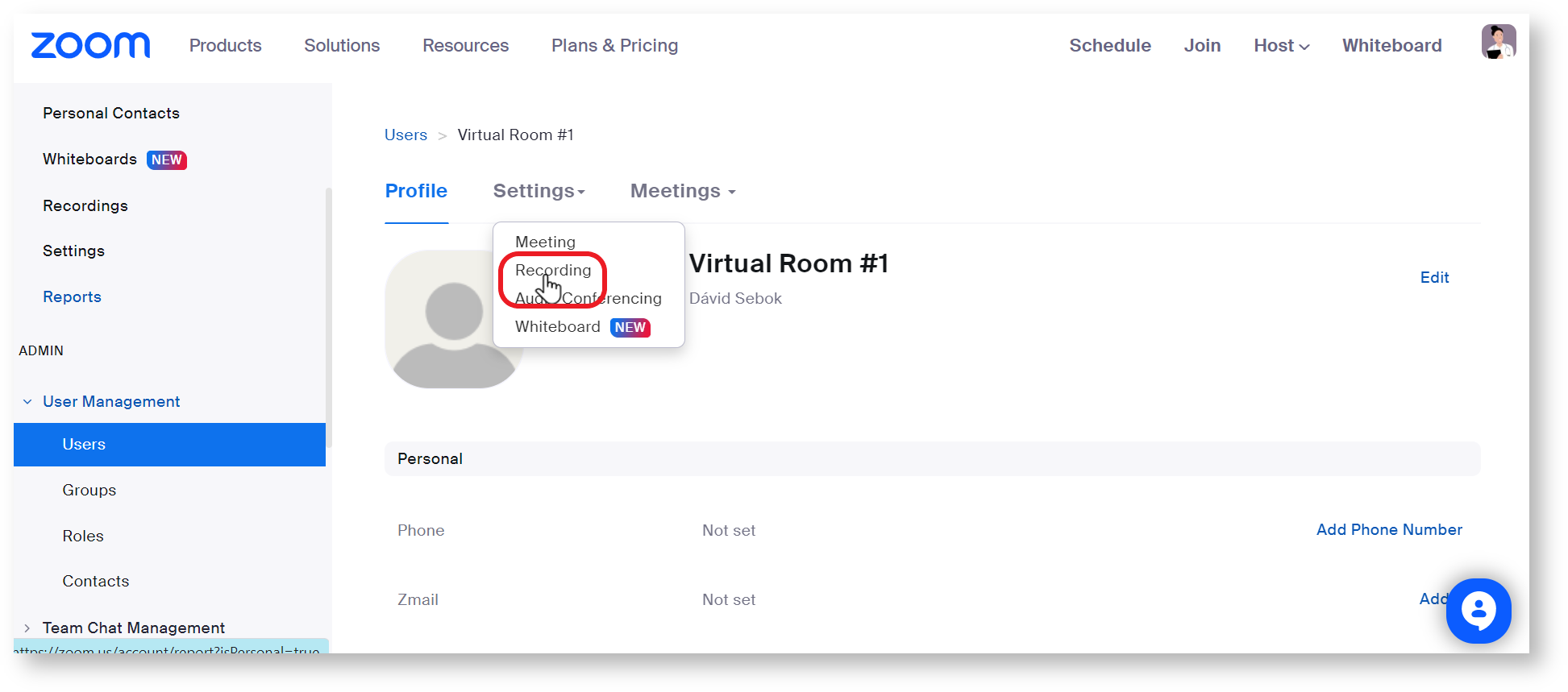
Scroll down to "Save chat messages from the meeting/webinar" under Cloud recording and make sure the checkbox is selected.
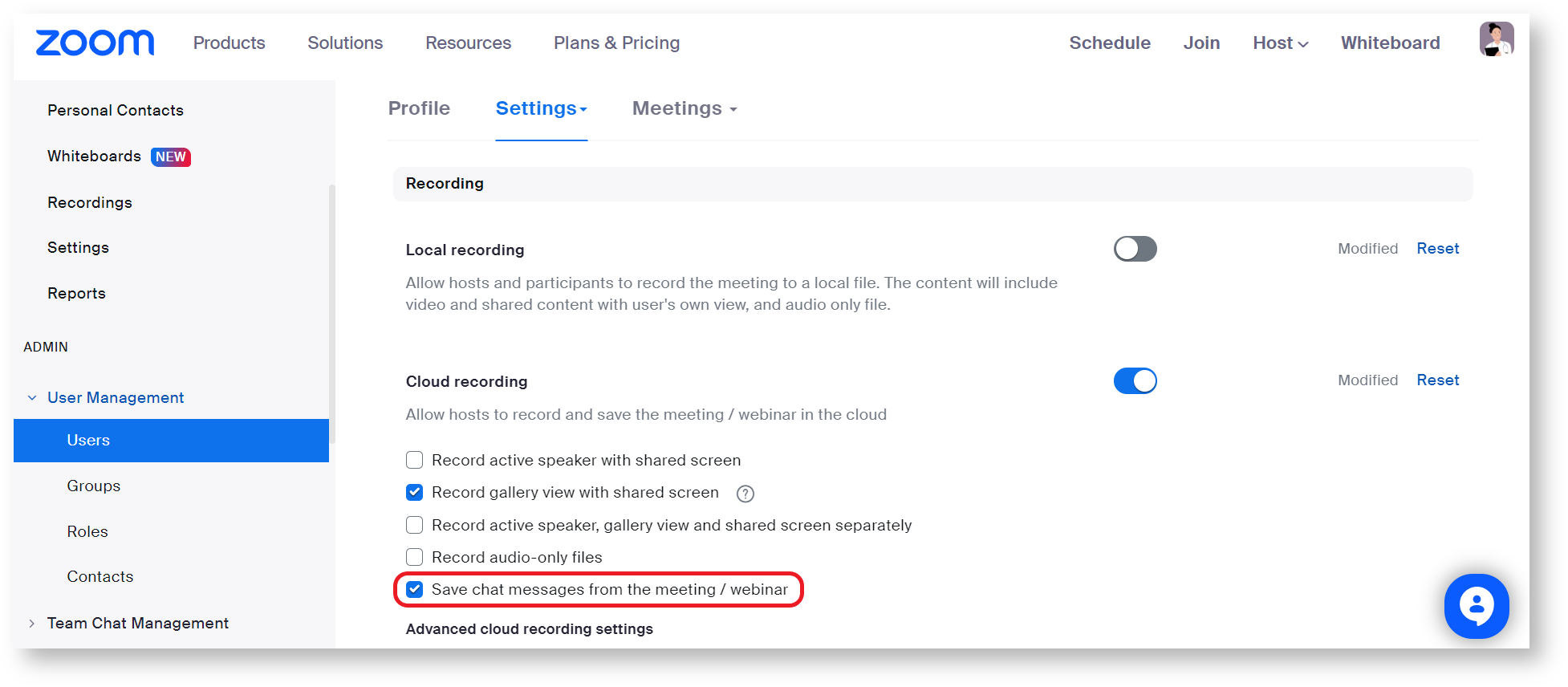
NOTE: JWT is not supported by Zoom any longer. We recommend that you create an OAuth app as described at Build an OAuth Application in Your Zoom Owner Account.
Chat files can be retrieved from the cloud storage in each licensed user account of a CAE LearningSpace virtual room:
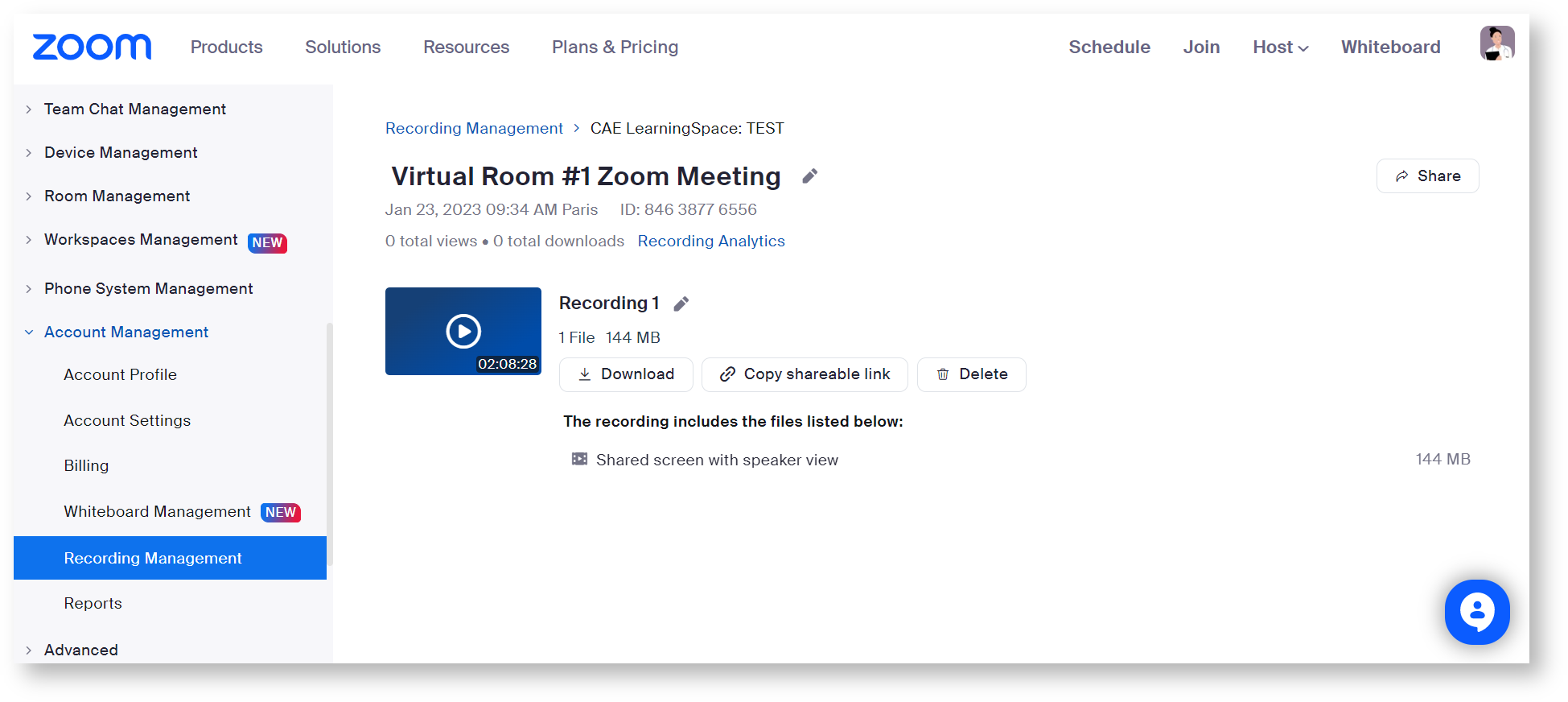
By default, once meeting recordings arrive in the Video Review module, they are automatically moved to the Trash folder in the virtual room's user account.
Disable Automatic Transfer of Zoom Cloud Recordings to the Trash Folder
Would you like your cloud recordings to remain in the Recording Management folder after they arrived in the Video Review module? Upon your request, we can disable the automatic transfer of Zoom cloud recordings to Trash. Contact CAE LearningSpace Customer Service for more information.
If a recording is in the Trash folder, you will not be able to download the meeting recording and its attachments—such as chat history or the separate audio file of the recording—from Zoom.
Deleted cloud recordings can be accessed for another 30 days after they were moved to the Trash:
How to Recover Recordings from the Trash Folder in Zoom
- Log into your Zoom owner account.
- Open Account Management under ADMIN on the left.
Select Recording Management.
Here, you can access the cloud recordings of every user registered in your owner account.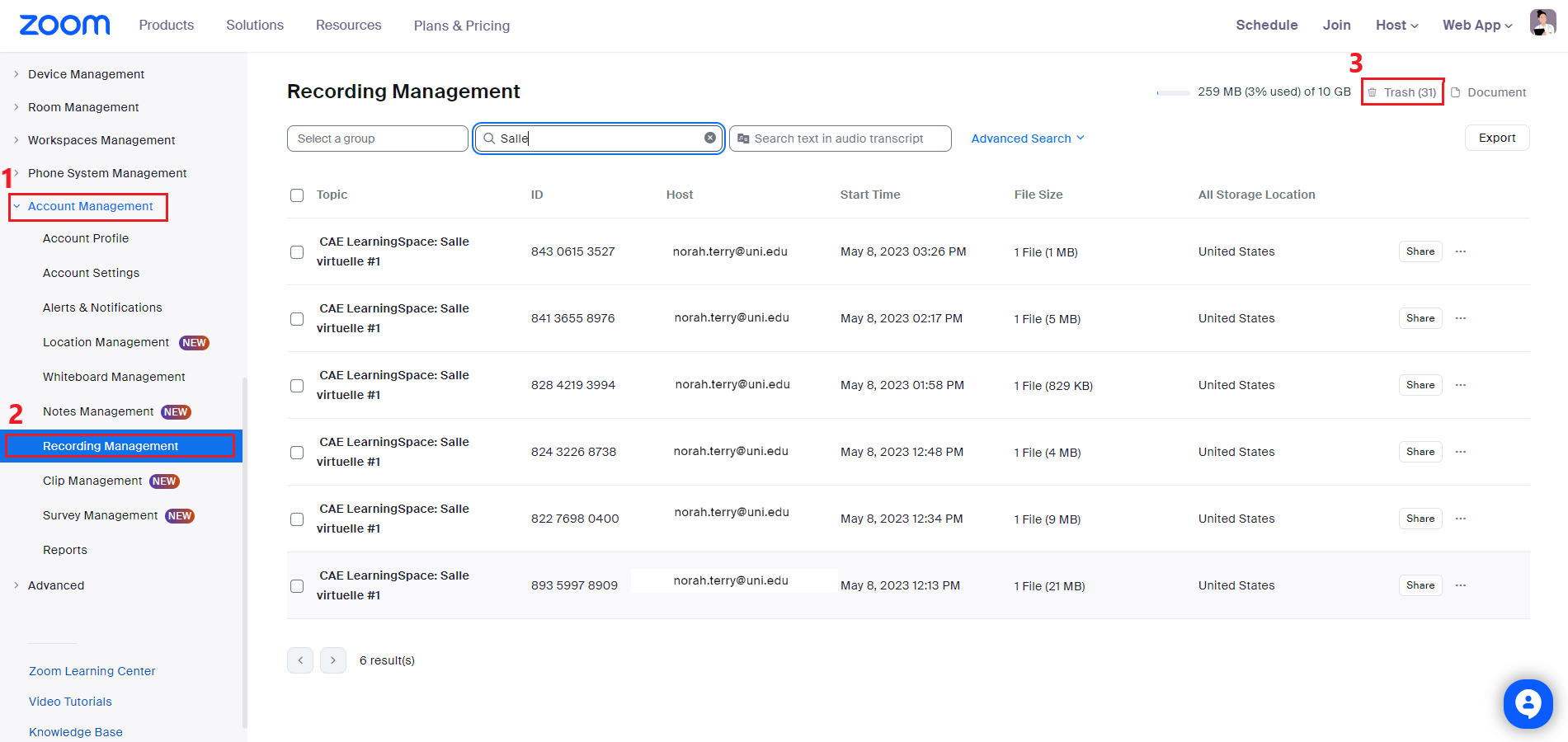
You can log straight into the Zoom user account of a virtual room to retrieve the recording of the virtual event.
If you log directly into an account, go to Recordings:
You can choose either option: here on, the steps of recovering your recordings from the trash are the same with either approach.
The screenshots included in this section show the recovering process inside an owner account.Go to the Trash folder: use the link on the right.
Select your recording from the list in the Trash folder.
Tip
The start time of each recording shows the moment when the SP in charge launched the virtual meeting from their learner pre-selection page. The recording immediately begins once the SP starts hosting the meeting.
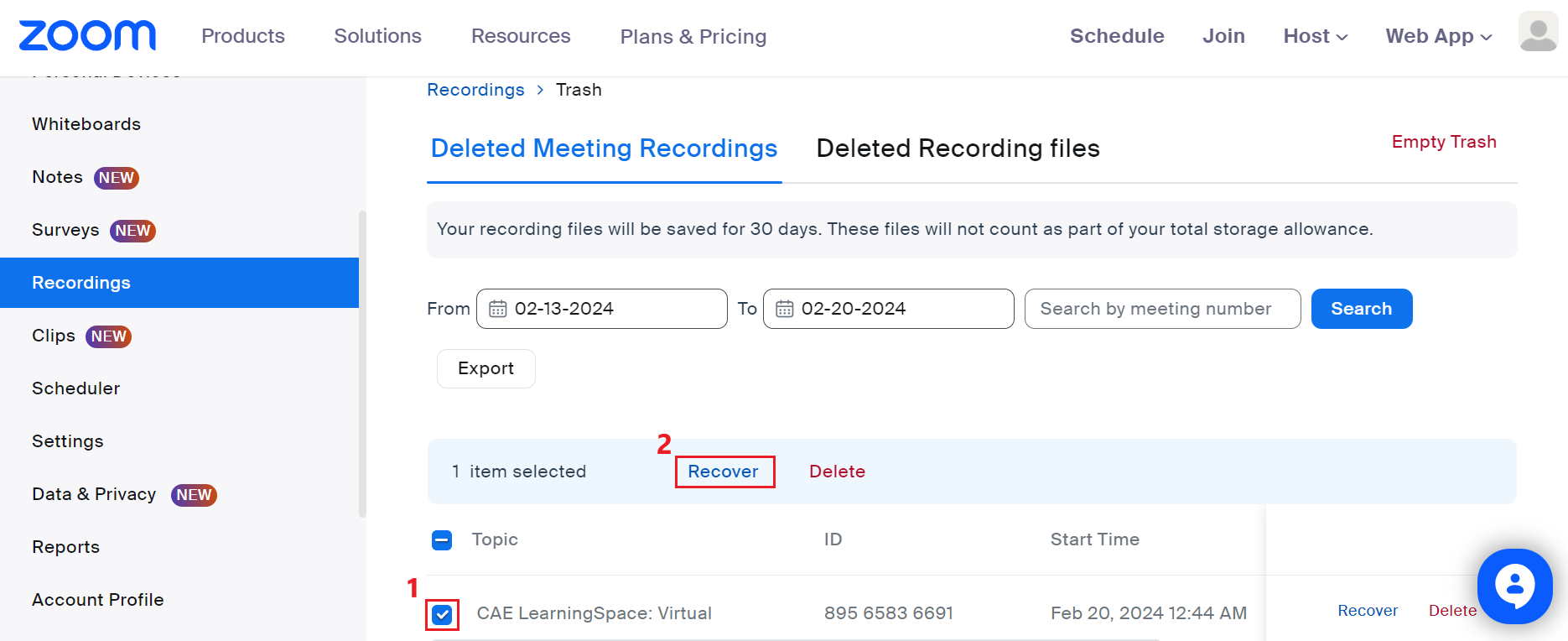
- Click Recover to move your recording back to your main recording page.
Confirm that you would like to recover the selected recording:

Otherwise, the recording remains in the Trash folder, and you will not be able to download the recording and its attachments—such as chat history or the separate audio file of the recording—from Zoom.
- Click on the My Recordings link at the top of your page to return from the Trash folder.
- Find your recovered video recording.

- Click on the Topic of the meeting recording to display every file of the meeting recording.
11. Hover over the chat file to view options.
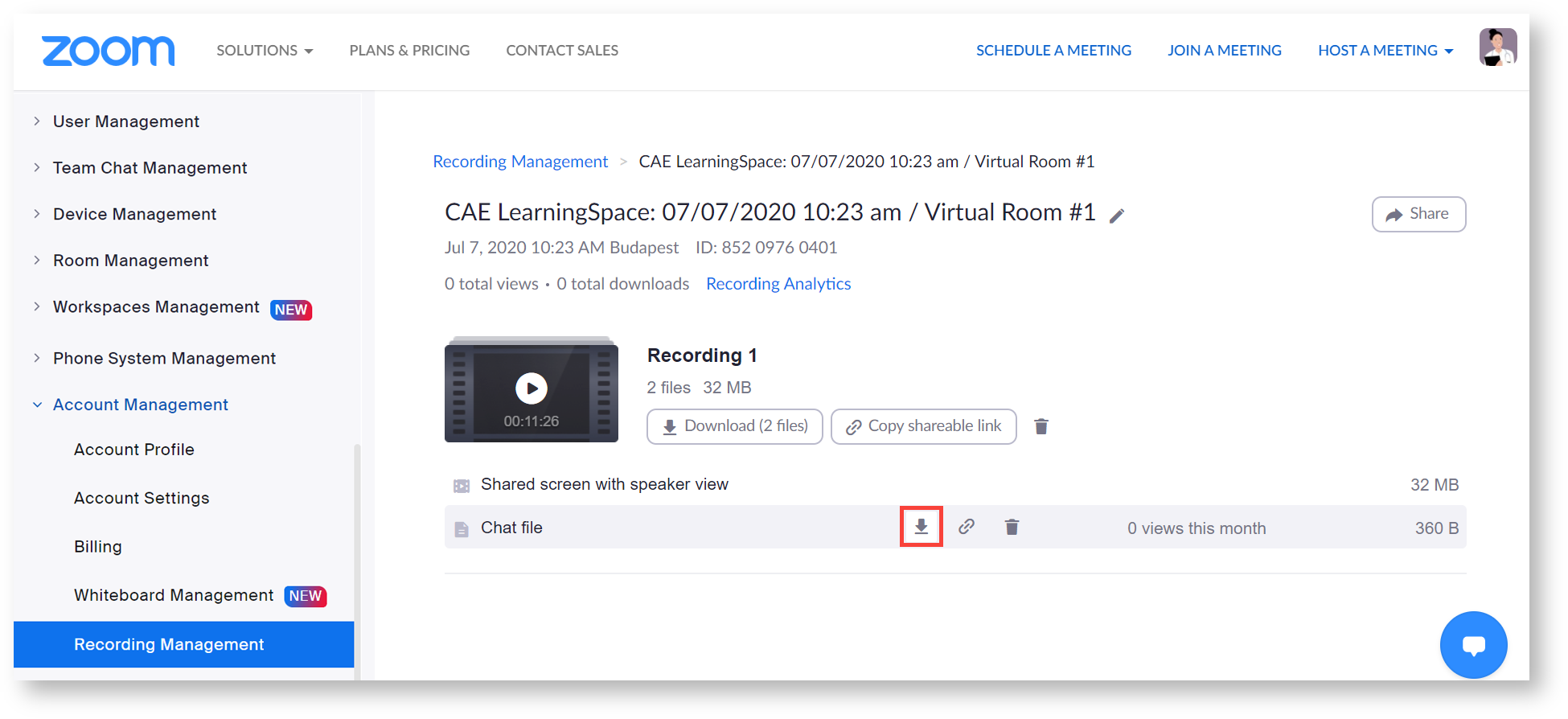
You can download, create a shareable link, or delete the chat history.
12. To display chat history side-by-side with the meeting recording, open the video recording by clicking on its title:
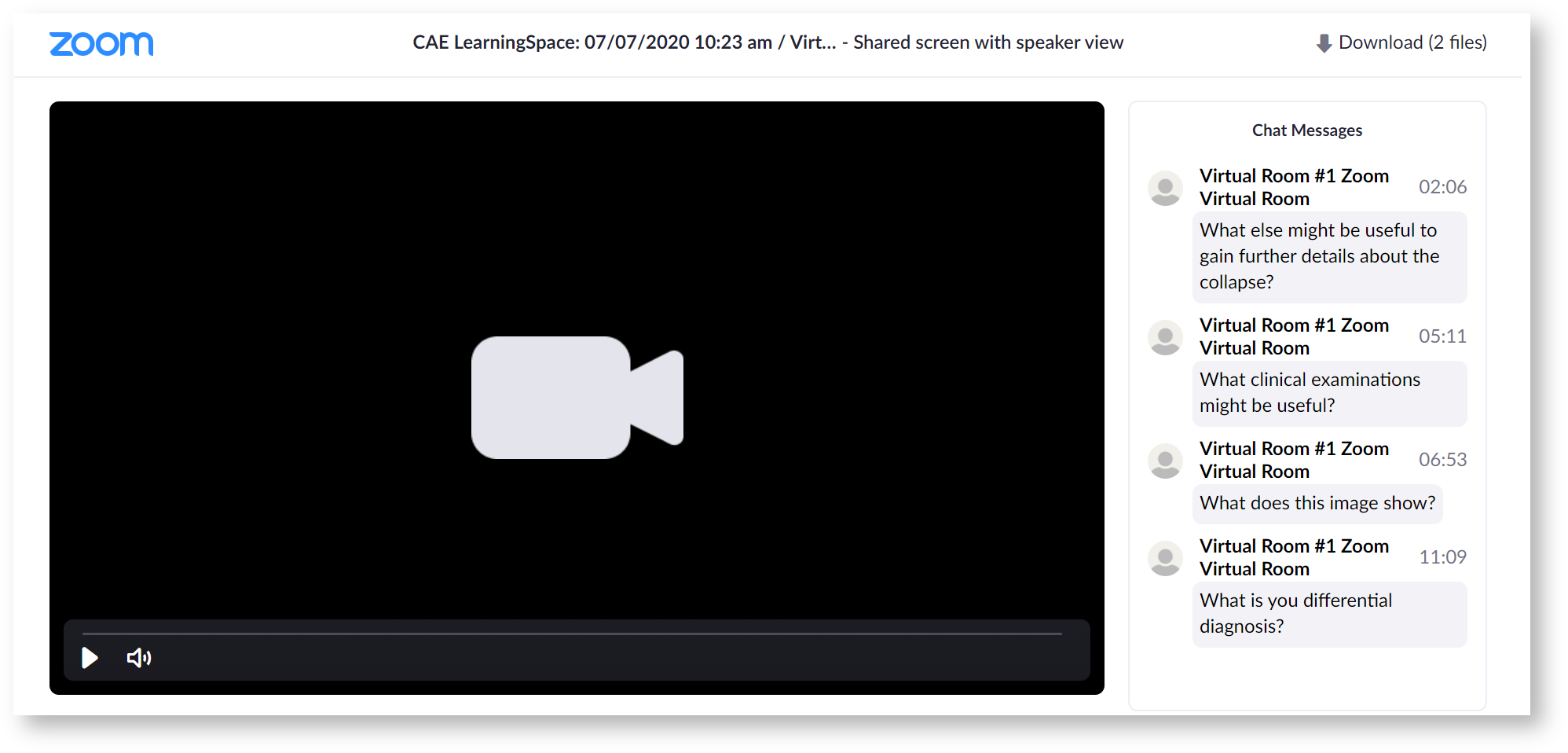
Save the Chat Locally
Saving Chat Conversations Locally
Set up auto-save in your Zoom owner account to apply the setting to every account registered as a User in the Zoom owner account. Every in-meeting chat message that the host receives directly—either one-on-one or sent to everyone—will be saved to the host's device when the meeting is ended to the default location specified by Zoom or a selected folder.
The folder containing the downloaded chat file will open automatically when the meeting is ended.
- Log into your Zoom owner account.
- Open Account Management on the left.
- Go to Account Settings.
- On the Meeting tab, scroll down to the Meeting chat - Auto-save setting.
You can find the setting in the In Meeting (Basic) section.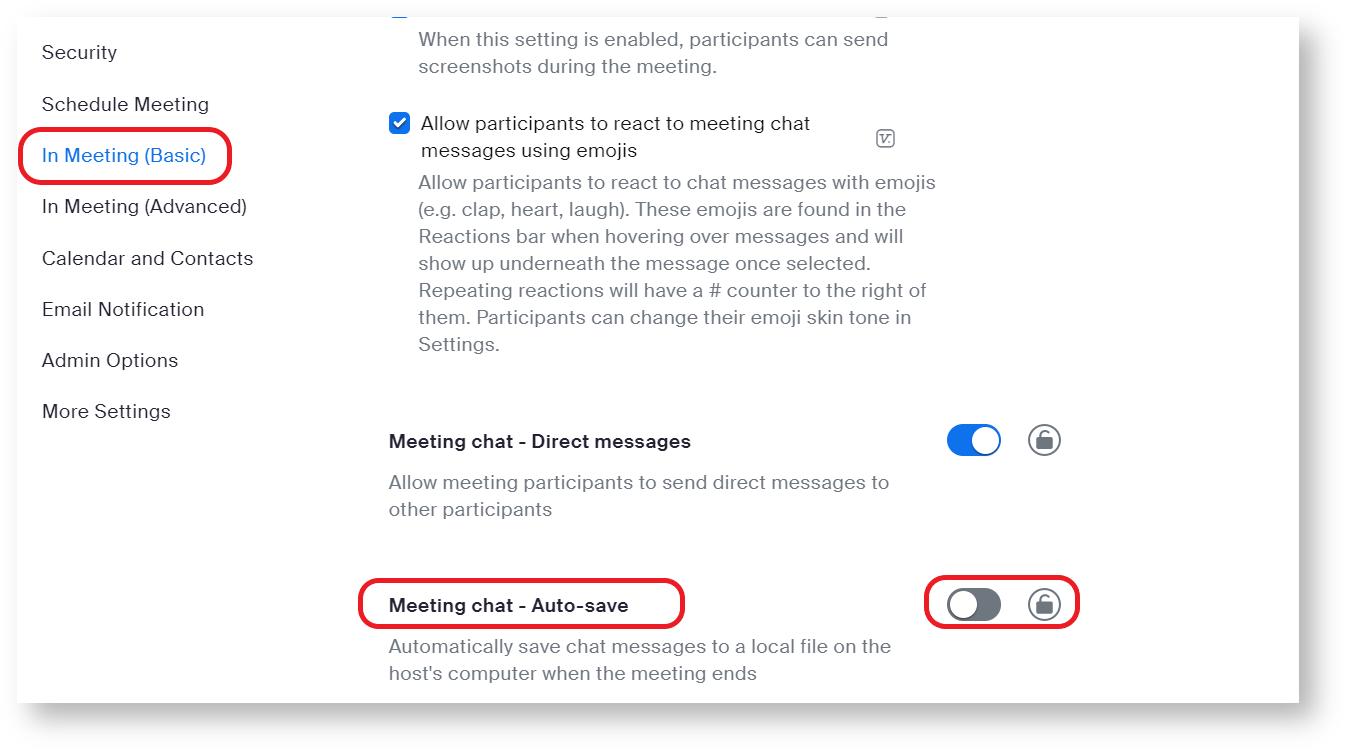
- Toggle the switch at Auto saving chats.
A dialogue will open where you have to confirm the setting: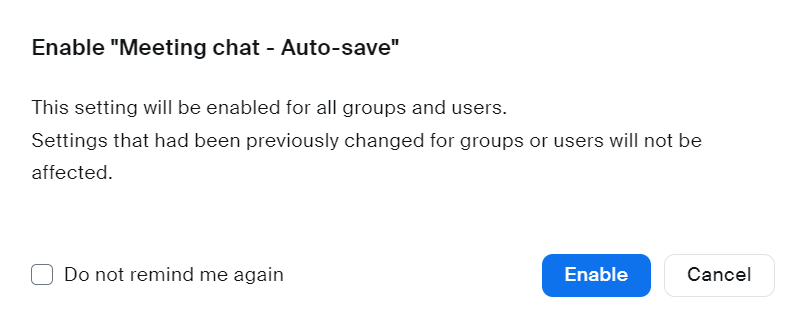
- Click Turn On, and your setting will be saved automatically.
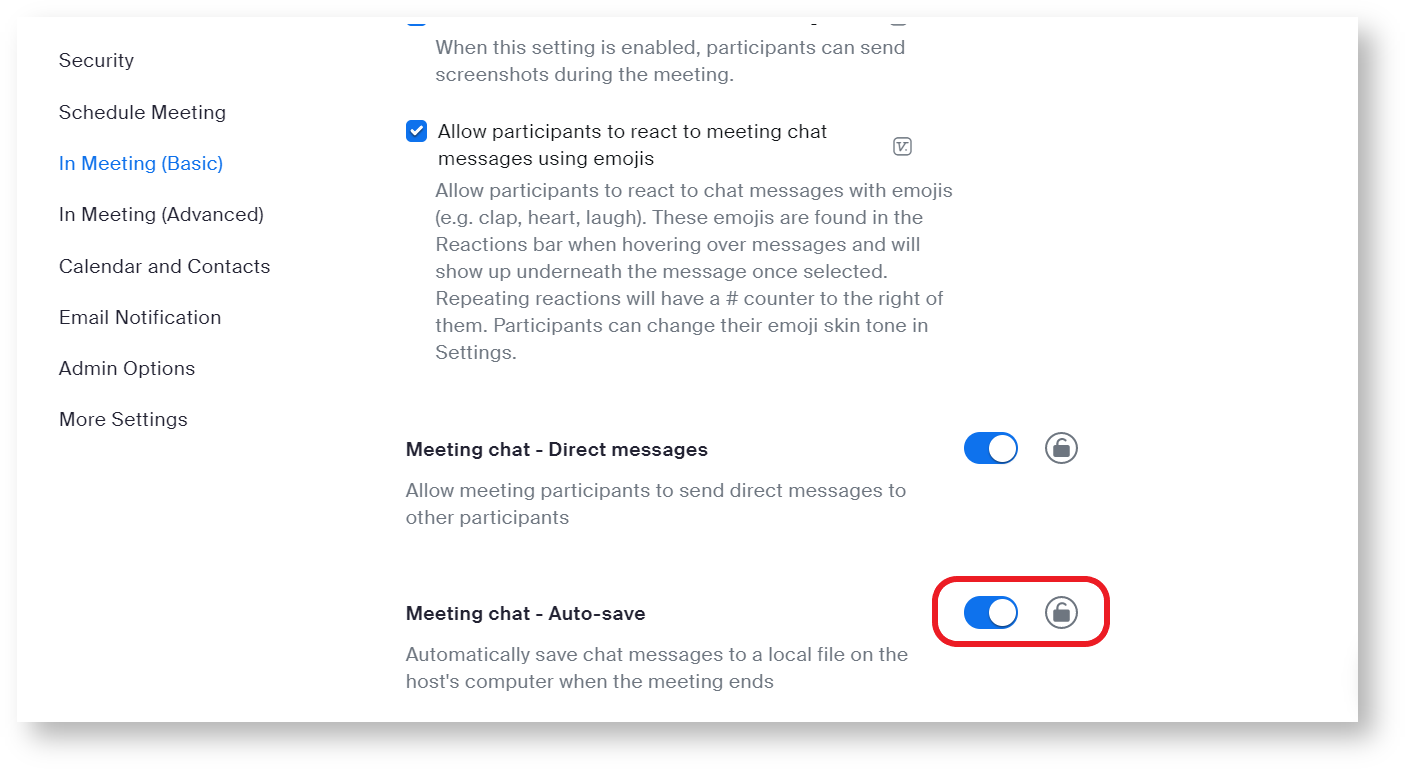
In case you do not want to apply auto-save to every user in your Zoom owner account, you can manage user settings individually with User Management.
- Open User Management on the left, then select Users.
- In Users, click on the user account you want to modify.
You will be redirected to the user account's profile page. - Once there, open the Settings drop-down.
- Select Meeting.
- Scroll down to "Auto saving chats" to adjust the setting for this particular user.
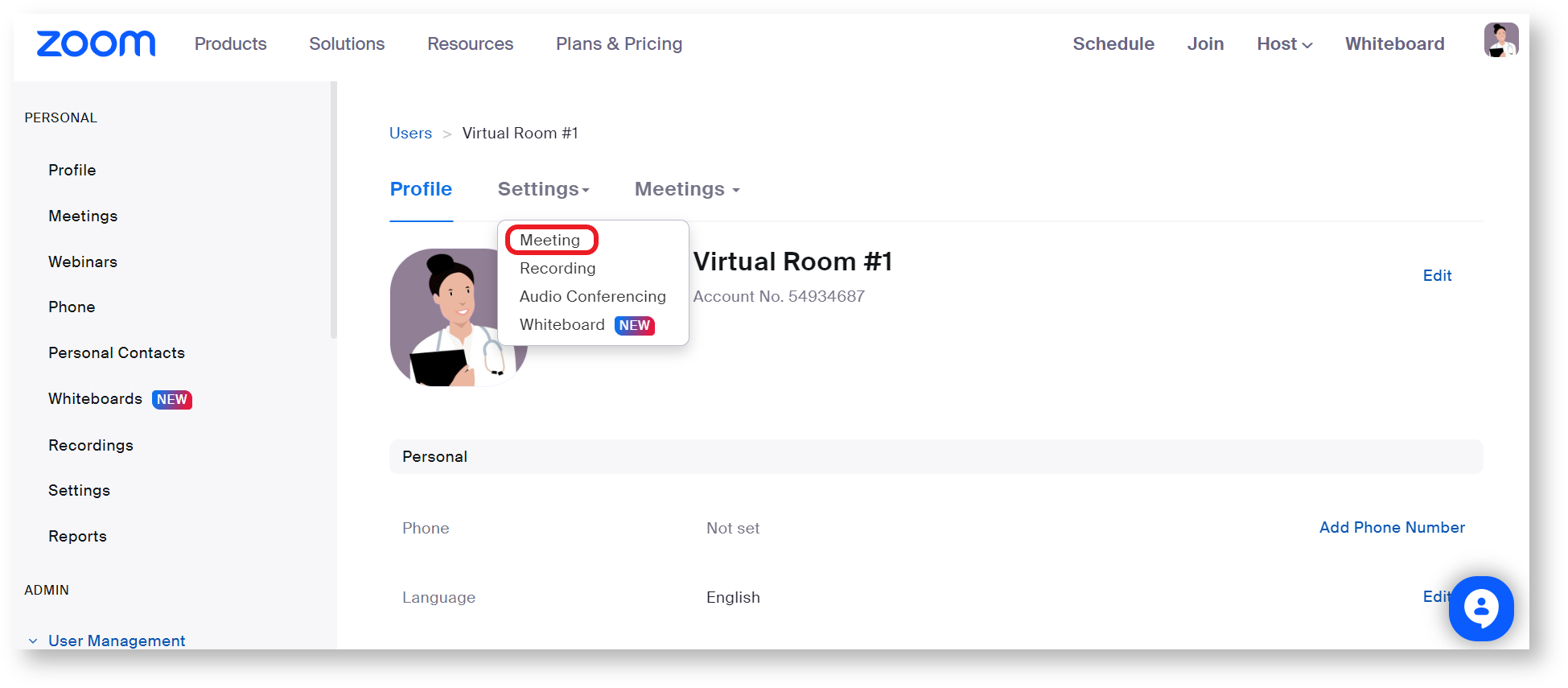
On to the Last Step
Continue to this page to set up your virtual rooms.